Gov. John Kasich came into his job focused on jobs.
His campaign touted the need to get Ohioans back to work. Over his first year and one-half in office, his attention to the job market hasn't waned.
In fact, Kasich has said work-force training — not his mid-cycle budget or promoting exploration of underground shale in eastern Ohio to unearth natural gas and oil — will be his administration"s biggest issue of 2012.
The governor says that employers across Ohio have had a common lament; that as more skilled-labor jobs become available, there are too few Ohioans adequately trained to fill those slots.
It's not a new problem. During his campaign the governor pledged to improve the state"s job retraining programs to better meet the needs of businesses in a changing economy.
"We have to train ourselves for the jobs that are going to come,” he told a gathering in Mount Vernon while on the campaign trail. "... we"re not just going to be stuck here in manufacturing. We'll do manufacturing as best as we can, but we also have to be involved in bio technology and computer information technology. We've got to retrain Ohioans and we need a whole new system to do that.”
Toward that end, Kasich ordered the creation of the Governor's Office of Workforce Transformation. He signed the executive order Feb. 9 at an appearance in Batavia.
The office is charged with coordinating workforce policies and programs across state government. The goal is to streamline a system which consisted of 77 different programs across 13 state agencies. Kasich hired Richard Frederick as executive director of the new office.
"If you have 77 and 13 it means you have zero. That's how I add that up,” Kasich said in January when he met with some editors and reporters at The Plain Dealer. Kasich said. "Nobody knows what anyone's doing.”
It will be Frederick's job to eliminate some of those 77 programs, merge others and settle on a single cohesive training plan linking high school education to community colleges and four-year universities, and to the business community.
That will be no small task, said Kasich spokesman Rob Nichols. "The 77 and 13, that was 45 years in the making,” he said.
The administration previously has cited figures for the number of jobs that sit empty for lack of qualified applicants. In mid January, the state said there are 72,341 open positions across Ohio which had gone unfilled as employers claim that the labor pool is too shallow and unqualified.
Nichols said that's a concern that's been voiced all around the state by employers who say they "can't find workers with the skill set needed to fill jobs.”
Kasich has said the business world itself has been part of the problem.
State officials said employers are quick to tell the state what type of workers they need for today but terrible about projecting forward. Forecasting is critical, Kasich"s office said, so that students can be encouraged to seek certain career paths on the promise that jobs will be available at the completion of their training or education.
"We have a mismatch. This is a huge problem,” Kasich said at the newspaper gathering. "We've got people who have jobs, and we've got people who they say don't have the skills to fit the jobs. So we're not matching them.”
Kasich's office says Ohio had a net gain of 43,000 jobs in 2011, his first year in office. The type of jobs the administration thinks will be most in demand in Ohio over the next few years are engineers, computer scientists, machinists, long-distance truck drivers, diesel mechanics and welders.
Based on his executive order, we can set the Kasich-O-Meter for progress on this promise at In the Works.

